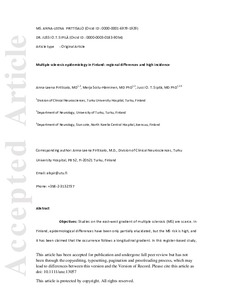Multiple sclerosis epidemiology in Finland: regional differences and high incidence
Sipilä JOT; Soilu-Hänninen M; Pirttisalo AL
https://urn.fi/URN:NBN:fi-fe2021042720280
Tiivistelmä
OBJECTIVES:
Studies on the east-west gradient of multiple
sclerosis (MS) are scarce. In Finland, epidemiological differences have
been only partially elucidated, but the MS risk is high, and it has been
claimed that the occurrence follows a longitudinal gradient. In this
register-based study, we updated the MS epidemiology in southwest
Finland (SwF) and compared it to the easternmost hospital district,
North Karelia (NK), for which no previous data exist.
MATERIAL AND METHODS:
Patients
with ICD-10 code G35 were identified from hospital district
administrative data. Patient records were reviewed to include only cases
with a definitive diagnosis. Incidence period covered 5 years
(2012-2016) and the prevalence date was December 31, 2016. Results were
standardized using the direct method.
RESULTS:
1184
persons had MS in SwF and 253 persons in NK at the end of 2016. The
prevalence was 280/100,000 (95% Cl 264-296) in SwF and 168/100,000 (95%
Cl 148-190) in NK (age-standardized for the European standard population
2013). During the incidence period, 211 new MS diagnoses were made in
SwF and 49 in NK. The annual age-standardized (ESP 2013) incidence was
12.1/100,000 person-years (95% Cl 10.5-13.8) in SwF and 8.6/100,000
person-years (95% Cl 6.4-11.2) in NK in the age group 10-69 years.
CONCLUSIONS:
There
are regional differences in MS epidemiology in Finland, possibly
related to demographic, social and genetic circumstances but the
retrospective nature and limited sample size of this study might
introduce some uncertainty to the calculations. SwF is a region with a
globally very high risk for MS. This article is protected by copyright.
All rights reserved.
Kokoelmat
- Rinnakkaistallenteet [19207]
